Robotics in the Timber Industry: Effects, Regulations, and Ethics
VerifiedAdded on 2023/06/11
|8
|1239
|224
Report
AI Summary
This report explores the potential impact of robotics on the timber industry, focusing on the benefits of automation such as increased efficiency and reduced labor shortages, as well as the potential drawbacks like environmental destruction. It addresses ethical considerations related to environmental pollution, sustainable power sources, and the preservation of forest cover and cultural beliefs. The report also examines the disruption caused by automation to traditional logging processes, highlighting the shift from manual labor to robotic systems, and the resulting changes in recruitment, training, and overall operational efficiency. The analysis provides insights into how timber industries can navigate the integration of robotics while adhering to ethical and environmental standards, promoting a balance between technological advancement and responsible resource management. Desklib provides a platform to access more solved assignments and study resources.

The potential impact of robotics on the Timber Industry
Name
Institution
Professor
Course
Date
Name
Institution
Professor
Course
Date
Paraphrase This Document
Need a fresh take? Get an instant paraphrase of this document with our AI Paraphraser
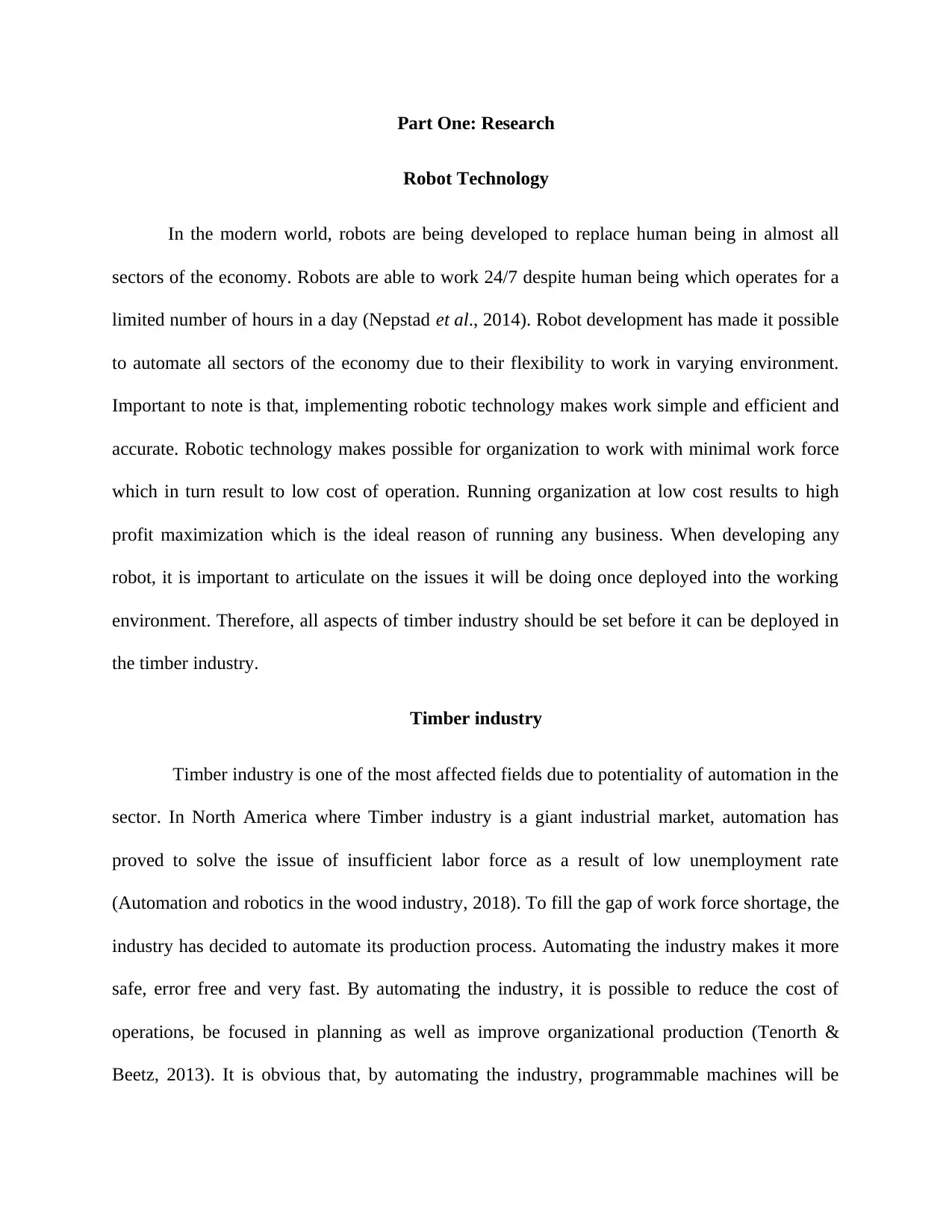
Part One: Research
Robot Technology
In the modern world, robots are being developed to replace human being in almost all
sectors of the economy. Robots are able to work 24/7 despite human being which operates for a
limited number of hours in a day (Nepstad et al., 2014). Robot development has made it possible
to automate all sectors of the economy due to their flexibility to work in varying environment.
Important to note is that, implementing robotic technology makes work simple and efficient and
accurate. Robotic technology makes possible for organization to work with minimal work force
which in turn result to low cost of operation. Running organization at low cost results to high
profit maximization which is the ideal reason of running any business. When developing any
robot, it is important to articulate on the issues it will be doing once deployed into the working
environment. Therefore, all aspects of timber industry should be set before it can be deployed in
the timber industry.
Timber industry
Timber industry is one of the most affected fields due to potentiality of automation in the
sector. In North America where Timber industry is a giant industrial market, automation has
proved to solve the issue of insufficient labor force as a result of low unemployment rate
(Automation and robotics in the wood industry, 2018). To fill the gap of work force shortage, the
industry has decided to automate its production process. Automating the industry makes it more
safe, error free and very fast. By automating the industry, it is possible to reduce the cost of
operations, be focused in planning as well as improve organizational production (Tenorth &
Beetz, 2013). It is obvious that, by automating the industry, programmable machines will be
Robot Technology
In the modern world, robots are being developed to replace human being in almost all
sectors of the economy. Robots are able to work 24/7 despite human being which operates for a
limited number of hours in a day (Nepstad et al., 2014). Robot development has made it possible
to automate all sectors of the economy due to their flexibility to work in varying environment.
Important to note is that, implementing robotic technology makes work simple and efficient and
accurate. Robotic technology makes possible for organization to work with minimal work force
which in turn result to low cost of operation. Running organization at low cost results to high
profit maximization which is the ideal reason of running any business. When developing any
robot, it is important to articulate on the issues it will be doing once deployed into the working
environment. Therefore, all aspects of timber industry should be set before it can be deployed in
the timber industry.
Timber industry
Timber industry is one of the most affected fields due to potentiality of automation in the
sector. In North America where Timber industry is a giant industrial market, automation has
proved to solve the issue of insufficient labor force as a result of low unemployment rate
(Automation and robotics in the wood industry, 2018). To fill the gap of work force shortage, the
industry has decided to automate its production process. Automating the industry makes it more
safe, error free and very fast. By automating the industry, it is possible to reduce the cost of
operations, be focused in planning as well as improve organizational production (Tenorth &
Beetz, 2013). It is obvious that, by automating the industry, programmable machines will be
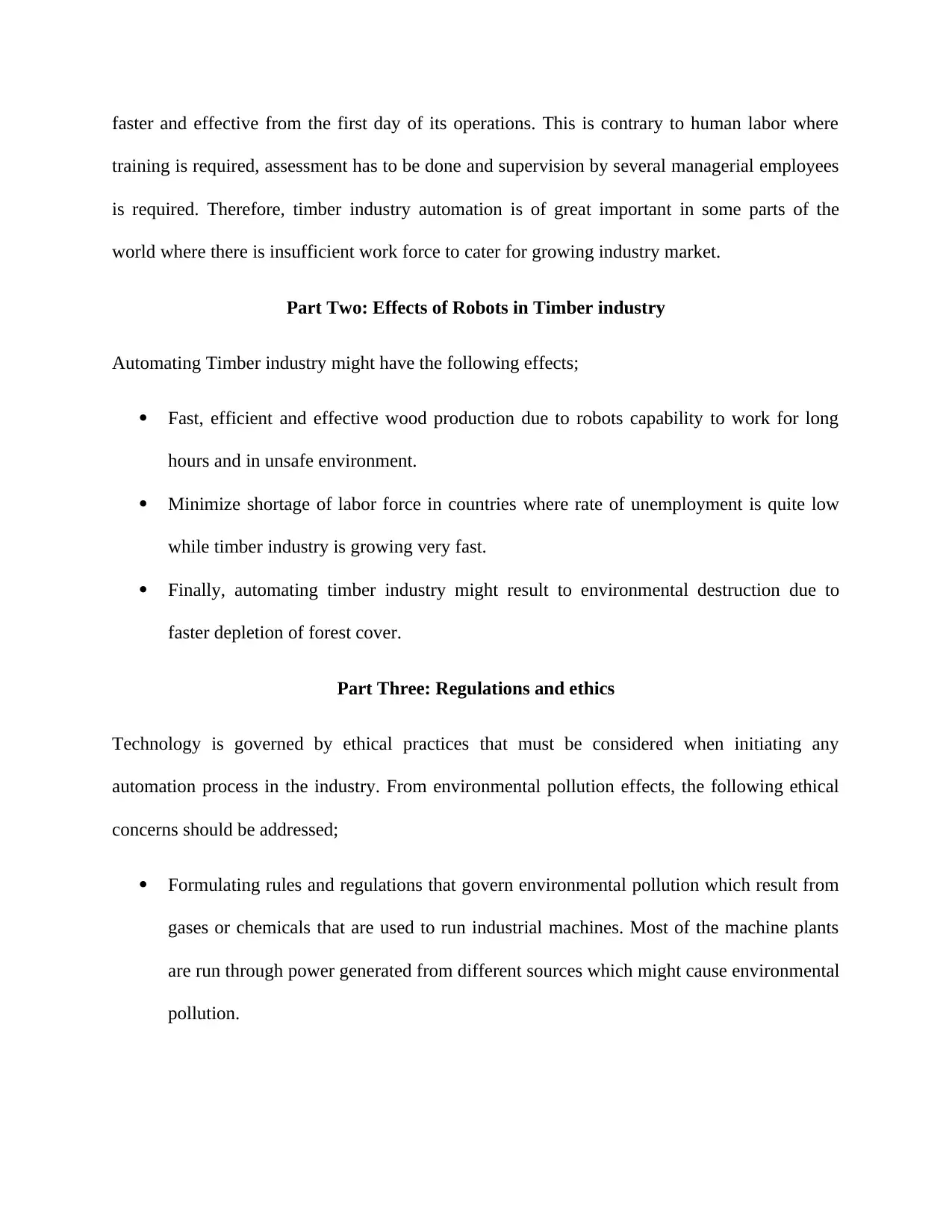
faster and effective from the first day of its operations. This is contrary to human labor where
training is required, assessment has to be done and supervision by several managerial employees
is required. Therefore, timber industry automation is of great important in some parts of the
world where there is insufficient work force to cater for growing industry market.
Part Two: Effects of Robots in Timber industry
Automating Timber industry might have the following effects;
Fast, efficient and effective wood production due to robots capability to work for long
hours and in unsafe environment.
Minimize shortage of labor force in countries where rate of unemployment is quite low
while timber industry is growing very fast.
Finally, automating timber industry might result to environmental destruction due to
faster depletion of forest cover.
Part Three: Regulations and ethics
Technology is governed by ethical practices that must be considered when initiating any
automation process in the industry. From environmental pollution effects, the following ethical
concerns should be addressed;
Formulating rules and regulations that govern environmental pollution which result from
gases or chemicals that are used to run industrial machines. Most of the machine plants
are run through power generated from different sources which might cause environmental
pollution.
training is required, assessment has to be done and supervision by several managerial employees
is required. Therefore, timber industry automation is of great important in some parts of the
world where there is insufficient work force to cater for growing industry market.
Part Two: Effects of Robots in Timber industry
Automating Timber industry might have the following effects;
Fast, efficient and effective wood production due to robots capability to work for long
hours and in unsafe environment.
Minimize shortage of labor force in countries where rate of unemployment is quite low
while timber industry is growing very fast.
Finally, automating timber industry might result to environmental destruction due to
faster depletion of forest cover.
Part Three: Regulations and ethics
Technology is governed by ethical practices that must be considered when initiating any
automation process in the industry. From environmental pollution effects, the following ethical
concerns should be addressed;
Formulating rules and regulations that govern environmental pollution which result from
gases or chemicals that are used to run industrial machines. Most of the machine plants
are run through power generated from different sources which might cause environmental
pollution.
⊘ This is a preview!⊘
Do you want full access?
Subscribe today to unlock all pages.

Trusted by 1+ million students worldwide
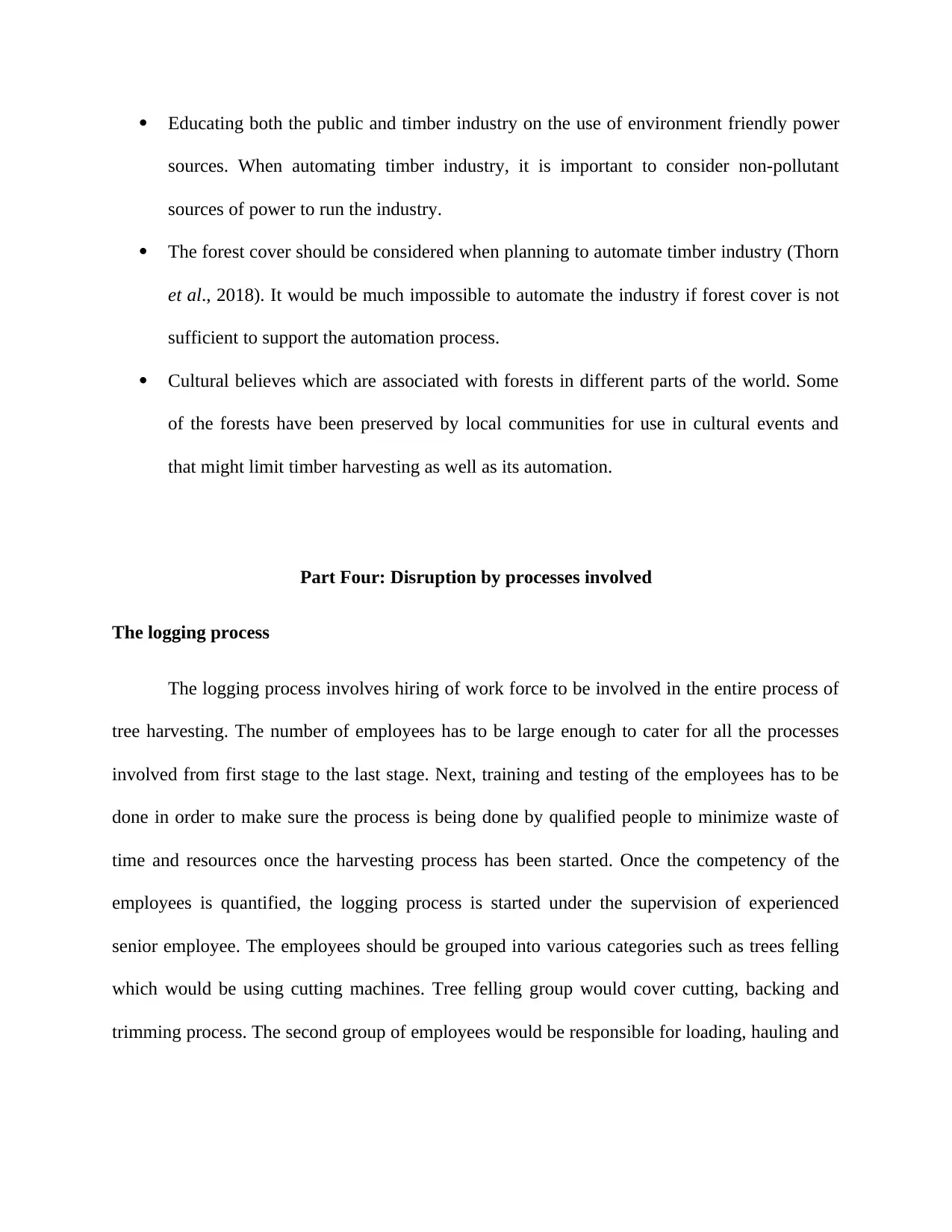
Educating both the public and timber industry on the use of environment friendly power
sources. When automating timber industry, it is important to consider non-pollutant
sources of power to run the industry.
The forest cover should be considered when planning to automate timber industry (Thorn
et al., 2018). It would be much impossible to automate the industry if forest cover is not
sufficient to support the automation process.
Cultural believes which are associated with forests in different parts of the world. Some
of the forests have been preserved by local communities for use in cultural events and
that might limit timber harvesting as well as its automation.
Part Four: Disruption by processes involved
The logging process
The logging process involves hiring of work force to be involved in the entire process of
tree harvesting. The number of employees has to be large enough to cater for all the processes
involved from first stage to the last stage. Next, training and testing of the employees has to be
done in order to make sure the process is being done by qualified people to minimize waste of
time and resources once the harvesting process has been started. Once the competency of the
employees is quantified, the logging process is started under the supervision of experienced
senior employee. The employees should be grouped into various categories such as trees felling
which would be using cutting machines. Tree felling group would cover cutting, backing and
trimming process. The second group of employees would be responsible for loading, hauling and
sources. When automating timber industry, it is important to consider non-pollutant
sources of power to run the industry.
The forest cover should be considered when planning to automate timber industry (Thorn
et al., 2018). It would be much impossible to automate the industry if forest cover is not
sufficient to support the automation process.
Cultural believes which are associated with forests in different parts of the world. Some
of the forests have been preserved by local communities for use in cultural events and
that might limit timber harvesting as well as its automation.
Part Four: Disruption by processes involved
The logging process
The logging process involves hiring of work force to be involved in the entire process of
tree harvesting. The number of employees has to be large enough to cater for all the processes
involved from first stage to the last stage. Next, training and testing of the employees has to be
done in order to make sure the process is being done by qualified people to minimize waste of
time and resources once the harvesting process has been started. Once the competency of the
employees is quantified, the logging process is started under the supervision of experienced
senior employee. The employees should be grouped into various categories such as trees felling
which would be using cutting machines. Tree felling group would cover cutting, backing and
trimming process. The second group of employees would be responsible for loading, hauling and
Paraphrase This Document
Need a fresh take? Get an instant paraphrase of this document with our AI Paraphraser
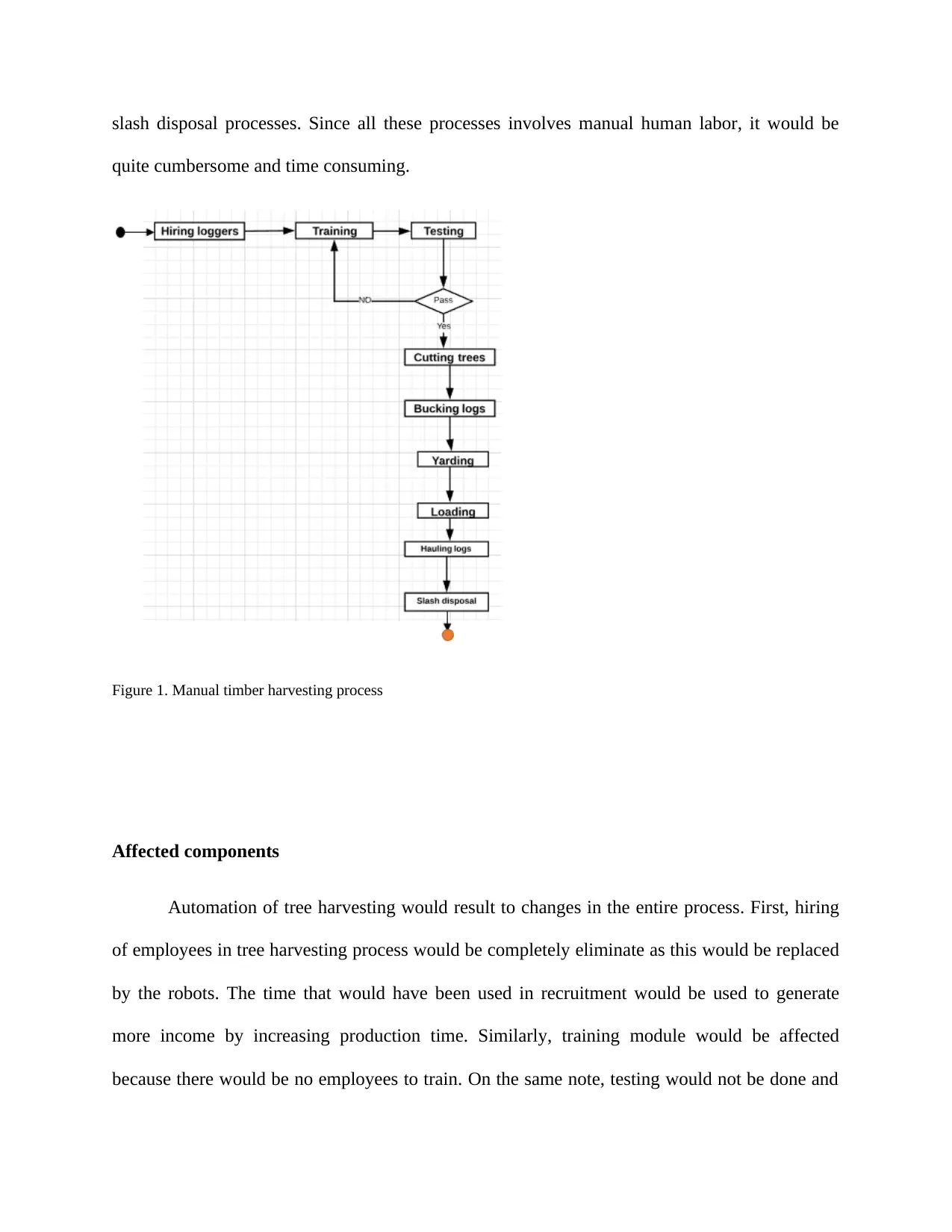
slash disposal processes. Since all these processes involves manual human labor, it would be
quite cumbersome and time consuming.
Figure 1. Manual timber harvesting process
Affected components
Automation of tree harvesting would result to changes in the entire process. First, hiring
of employees in tree harvesting process would be completely eliminate as this would be replaced
by the robots. The time that would have been used in recruitment would be used to generate
more income by increasing production time. Similarly, training module would be affected
because there would be no employees to train. On the same note, testing would not be done and
quite cumbersome and time consuming.
Figure 1. Manual timber harvesting process
Affected components
Automation of tree harvesting would result to changes in the entire process. First, hiring
of employees in tree harvesting process would be completely eliminate as this would be replaced
by the robots. The time that would have been used in recruitment would be used to generate
more income by increasing production time. Similarly, training module would be affected
because there would be no employees to train. On the same note, testing would not be done and
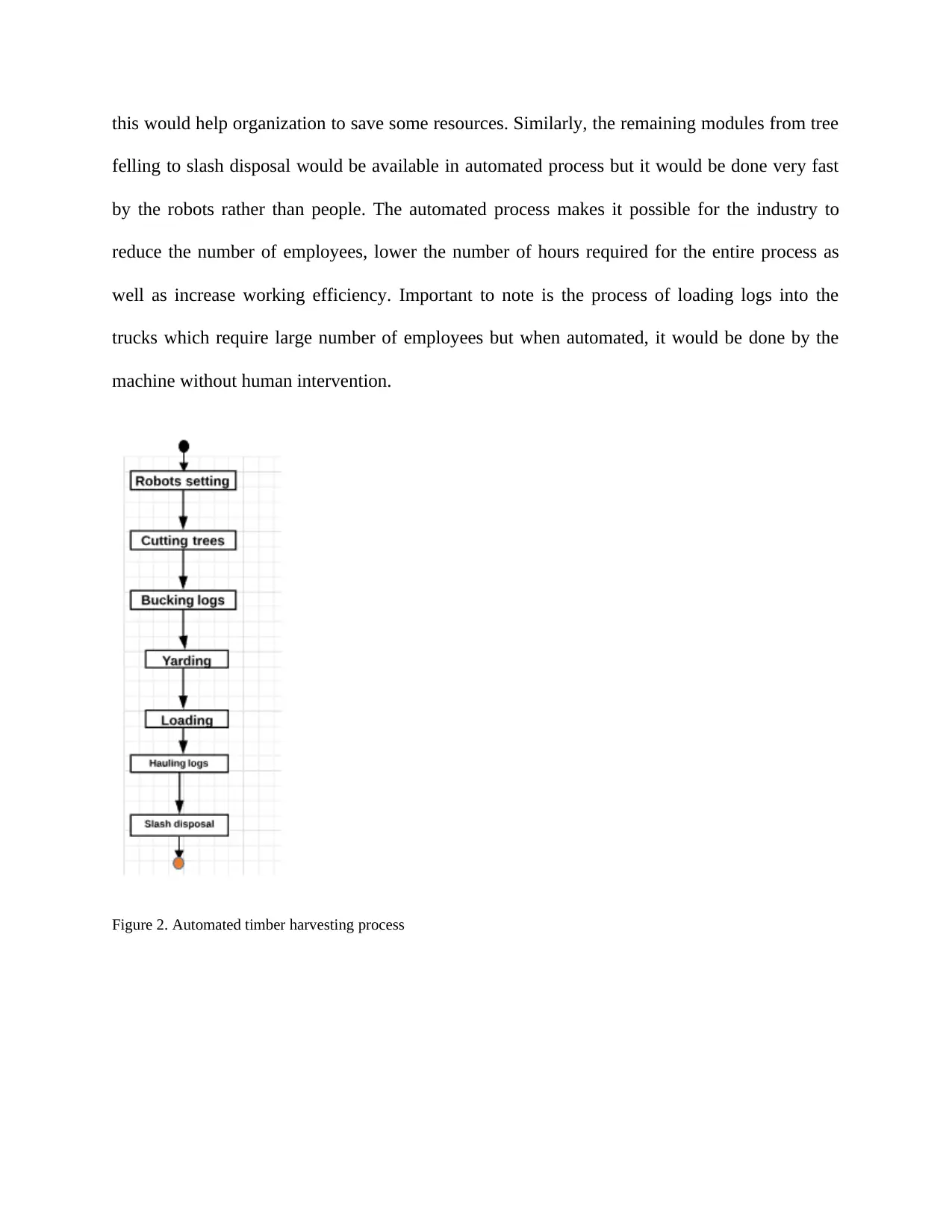
this would help organization to save some resources. Similarly, the remaining modules from tree
felling to slash disposal would be available in automated process but it would be done very fast
by the robots rather than people. The automated process makes it possible for the industry to
reduce the number of employees, lower the number of hours required for the entire process as
well as increase working efficiency. Important to note is the process of loading logs into the
trucks which require large number of employees but when automated, it would be done by the
machine without human intervention.
Figure 2. Automated timber harvesting process
felling to slash disposal would be available in automated process but it would be done very fast
by the robots rather than people. The automated process makes it possible for the industry to
reduce the number of employees, lower the number of hours required for the entire process as
well as increase working efficiency. Important to note is the process of loading logs into the
trucks which require large number of employees but when automated, it would be done by the
machine without human intervention.
Figure 2. Automated timber harvesting process
⊘ This is a preview!⊘
Do you want full access?
Subscribe today to unlock all pages.

Trusted by 1+ million students worldwide
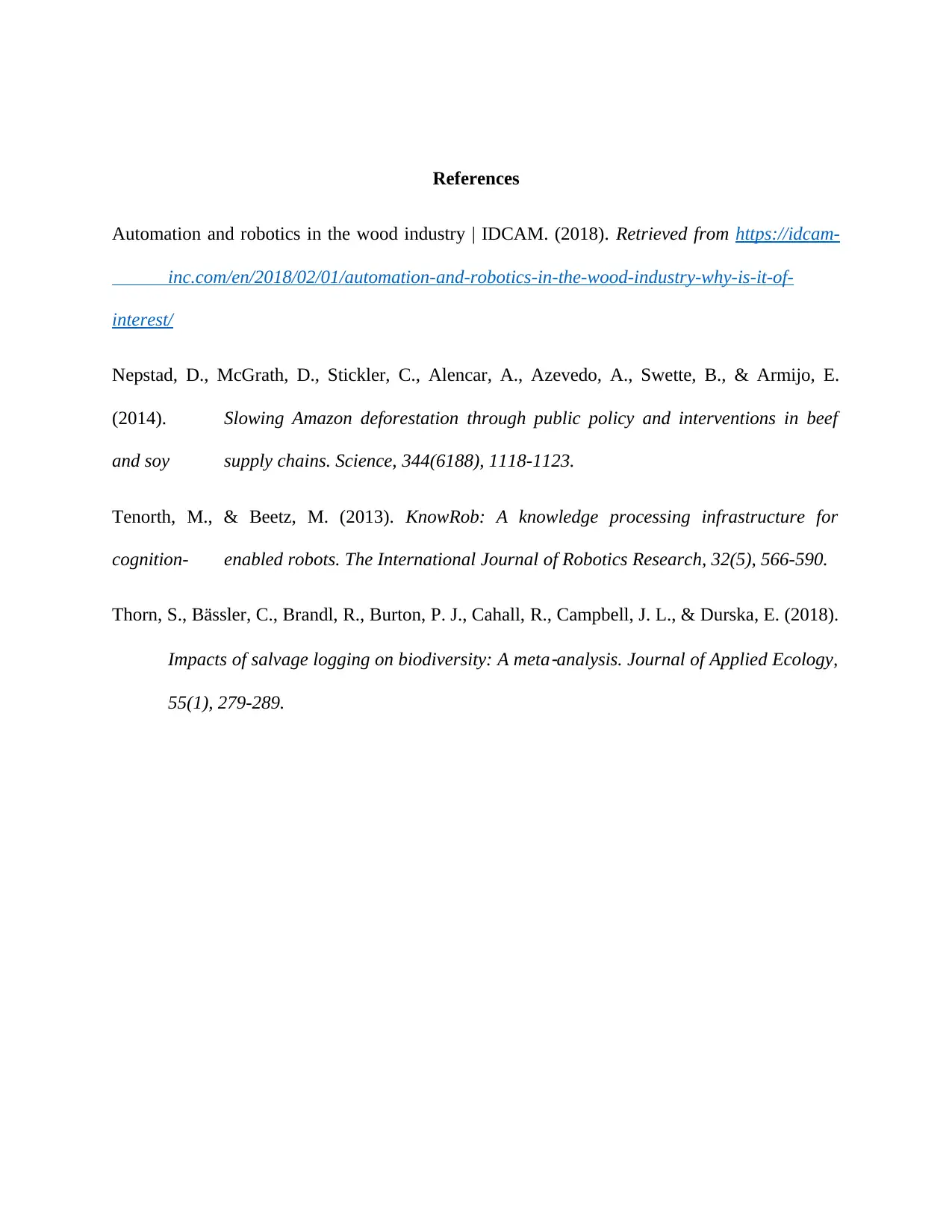
References
Automation and robotics in the wood industry | IDCAM. (2018). Retrieved from https://idcam-
inc.com/en/2018/02/01/automation-and-robotics-in-the-wood-industry-why-is-it-of-
interest/
Nepstad, D., McGrath, D., Stickler, C., Alencar, A., Azevedo, A., Swette, B., & Armijo, E.
(2014). Slowing Amazon deforestation through public policy and interventions in beef
and soy supply chains. Science, 344(6188), 1118-1123.
Tenorth, M., & Beetz, M. (2013). KnowRob: A knowledge processing infrastructure for
cognition- enabled robots. The International Journal of Robotics Research, 32(5), 566-590.
Thorn, S., Bässler, C., Brandl, R., Burton, P. J., Cahall, R., Campbell, J. L., & Durska, E. (2018).
Impacts of salvage logging on biodiversity: A meta
‐analysis. Journal of Applied Ecology,
55(1), 279-289.
Automation and robotics in the wood industry | IDCAM. (2018). Retrieved from https://idcam-
inc.com/en/2018/02/01/automation-and-robotics-in-the-wood-industry-why-is-it-of-
interest/
Nepstad, D., McGrath, D., Stickler, C., Alencar, A., Azevedo, A., Swette, B., & Armijo, E.
(2014). Slowing Amazon deforestation through public policy and interventions in beef
and soy supply chains. Science, 344(6188), 1118-1123.
Tenorth, M., & Beetz, M. (2013). KnowRob: A knowledge processing infrastructure for
cognition- enabled robots. The International Journal of Robotics Research, 32(5), 566-590.
Thorn, S., Bässler, C., Brandl, R., Burton, P. J., Cahall, R., Campbell, J. L., & Durska, E. (2018).
Impacts of salvage logging on biodiversity: A meta
‐analysis. Journal of Applied Ecology,
55(1), 279-289.
Paraphrase This Document
Need a fresh take? Get an instant paraphrase of this document with our AI Paraphraser

1 out of 8
Related Documents
Your All-in-One AI-Powered Toolkit for Academic Success.
+13062052269
info@desklib.com
Available 24*7 on WhatsApp / Email
![[object Object]](/_next/static/media/star-bottom.7253800d.svg)
Unlock your academic potential
Copyright © 2020–2025 A2Z Services. All Rights Reserved. Developed and managed by ZUCOL.





